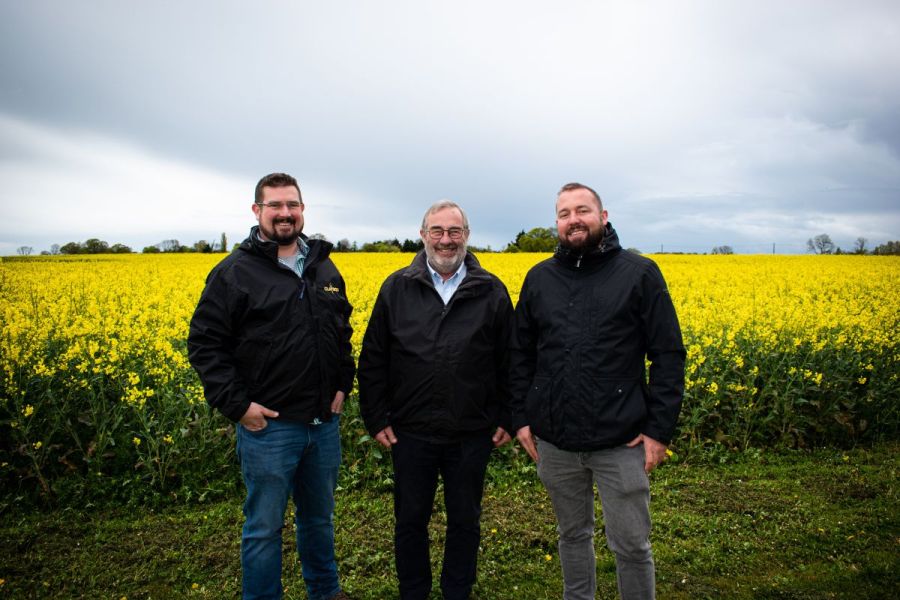From humble beginnings to a globally recognised brand, Claydon has firmly cemented its place as a leader in British manufacturing. CPM finds out what’s in store for the firm over the year ahead.
“If we can find enough people and resources, we could double our turnover this year.”
By Charlotte Cunningham
The flowering crop of oilseed rape looks typically on-brand as it lines the sprawling drive down to Claydon HQ and farm in Suffolk.
But behind the plumes of yellow that span the edges of the fields, founder Jeff Claydon points out a hollow patch in the centre as he begins to talk, rather disheartened, about the damage the mighty mouth of the cabbage stem flea beetle has done to his crops this year. “It has been a difficult year for the OSR,” he says. “It all started to go wrong last harvest; it was so dry we were unable to get the crop away. We caught a thunderstorm at the end of August and had about 30mm of rain, so it was sown on the August bank holiday, but as we’ve learnt in the past this is the exact migration time of the cabbage stem flea beetle. About 30% of our area has failed this year.”
But rather than dwelling on difficulties, Jeff has a long-standing history of turning challenges into opportunities…
According to the Oxford English Dictionary, a pioneer is defined as someone who is the first to study or develop a certain area – a trailblazer, for want of a better word. And with more than 40 years in the game, one could justifiably describe Jeff as a pioneer of single-pass kit – the likes of which has come into vogue rapidly over the past few years.
What today is a globally recognised brand started from much more humble beginnings – from simply Jeff ‘tinkering’ in a shed at the farm at what is now Claydon’s HQ in Wickhambrook to develop solutions that allowed farmers to keep yields high, but costs low.
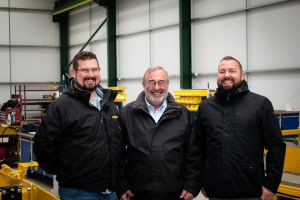
Despite now being a globally recognised brand, Claydon has remained true to its roots and stayed as a family run business, with Jeff Claydon’s sons Oliver and Spencer supporting both the factory and farm. (L-R: Oliver, Jeff and Spencer Claydon)
Farming and agriculture itself was very different 40 years ago too, however, the fundamental principles behind Claydon and its kit means the firm has stayed relevant in a changing landscape – remaining a brand that produces kit for farmers, by farmers, with everything still tested on the family farm.
“If we go back to 2000, we had that horrible time when wheat prices really fell through the floor and were about £60/t,” recalls Jeff. “Everybody was losing money and that led us to lower cost establishment techniques with the Claydon drill. For the past 20 years, that has allowed us to establish our crops with as little as 16 l/ha of fuel.”
While wheat prices in 2023 are more favourable than the lows of 2000, margins are still incredibly tight amid a background of rising input costs and a failure of commodity prices to remain at the highs seen last season to offset some of the increased costs. “Gas and electric have gone through the roof which has pushed everything up – from fertiliser to transport costs,” says Jeff.
On top of this, the move away from BPS has seen greater emphasis on ‘green’ farming, putting further pressure on the industry as a whole to reduce inputs and impacts of their operations. “There’s a major shift towards soil health and less fuel, as well as a major move to be more wildlife friendly too. We’re now ticking all those boxes with our kit, despite it being pioneered over 20 years ago,” remarks Jeff.
“With our kit we have, on favourable fields, been able to do the whole operation – right through to harvesting – on less than 50 l/ha of diesel. This has cut down not only servicing, machine and labour costs, but also the impact on the environment of our operations. This has put us, as a farm, in a very strong position to move forward. Over the years, we’ve been continually making these savings which has enabled us to be profitable before we’ve taken the government cheque.
“Our soil health is now remarkable compared with when we started – it has exceeded all expectations. Something we’re really focused on now is keeping the drainage on fields in tip-top condition because we see in areas that are not drained so well that the crops are lacklustre and don’t perform. So, investment over the past few years has gone into using kit to improve wet areas and corners of fields and those areas now are as good as the rest of the field, which is keeping our yields at nice even levels.”
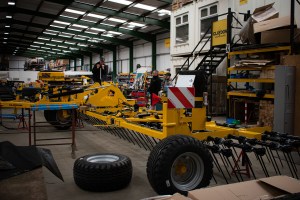
Everything is manufactured at the Claydon HQ in Suffolk, with new innovation tried and tested on the family farm.
Increased worm count has also helped improve soil conditions, and Jeff says he sees more wildlife now than ever before too – with many more birds visiting the farm, in particular. “Unfortunately, that includes seagulls which are raiding our soils for the worms,” he laughs.
So what does 2023 hold for the firm? “In this current climate, we’re seeing that the advantages of the Claydon system are coming of age and people are now really recognising the benefits of time and fuel savings it brings, as well as the ability to sow strong crops at a very low cost, with very high yields,” explains Jeff. “With Defra now offering grants to buy into products like this, it has also brought more interest.”
Jeff’s son Spencer joins the conversation and explains how export markets are looking to be a particularly exciting avenue for the firm over the coming years. “Exports account for about 60% of business now, with particular interest in countries like Germany and Poland, and products being shipped now to more than 20 countries. Without the war, Ukraine would be a huge market for us too.
“Everything we’ve been talking about for the past 20 years is extremely topical at the moment. We’re noticing that more and more people are looking at no-till and direct drilling, knowing they want to go down that route but also wanting to maintain yields and produce reliable results, and our system works as a bit of a half-way house between traditional and no-tillage approaches.”
Jeff adds: “If we can find enough people and resources, we could double our turnover this year.”
To facilitate this demand, the factory has recently expanded to include a brand new 36m2 production facility which was completed last autumn, with further expansion planned for the future. “The building has been fitted with four cranes to increase the assembly capacity and it’s there to grow,” says Jeff.
Though facilities are being developed, finding labour to cope with demand is currently the biggest challenge to the business, notes Spencer. At present, most processes are done by hand which isn’t always the most efficient approach. As such, automating some of the factory processes and looking to robotics are avenues currently being pursued, as well as subcontracting out the build of some of the elements within the kit.

The Claydon factory has recently expanded to include a new 1296m2 production facility to meet increased demand.
Kit-wise, it’s the Evolution range that’s taking centre-stage this year. Comprising nine mounted machines in a range of working widths – from 3m to 6m – the Evolution range brings together all the “best bits” from the Hybrid mounted and trailed ranges, explains Spencer. “We brought the mounted Hybrid range out over 10 years ago now, and it has been a real bread and butter product for us. We then brought out trailed drills in 2015 and they had various advantages, such as cutting discs and larger hopper capacity – which could never quite be achieved with the mounted drills.
“So what we wanted to do with the Evolution range is bring all the features we could together in a mounted machine. Essentially, the DNA is the same as what’s found in those original ranges. We haven’t reinvented the wheel because we don’t need to – we know this works and is what our customers like.”
However, the Evolution does offer a few enhanced features over its ancestors, like the new tine arrangement. “It’s also more compact in places to allow better trash flow,” adds Spencer. “There is a big demand for mounted kit in the UK and with the new Evolution drills we’ve seen sales increase significantly.”
Keen to sell complete solutions rather than just standalone kit, hosting trials at the Claydon farm continues to be part of the ethos. As well as working with agronomy firms like Agrii and Hutchinsons, Claydon has partnered with Olmix Micromix to look at two biostimulant programmes this season.
“We have always looked at innovations that can increase yield,” explains Jeff. “Olmix has encouraged me to host this biostimulant trial to see if they can bring more yield to the party, but we also want to see if we can improve the soil health further via different nutrition.”
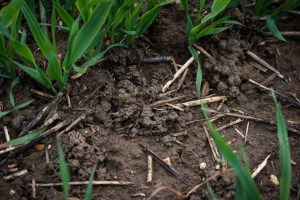
The abundance of worm casts is indicative of the vast improvements made to soil health at the Claydon farm over the past 20 years.
The plots are 36m in width and run the field length (360m) and are set to compare two products – Neosol, a soil microbial biomass activator, and Primeo S12, a soil nutrition stimulator, both of which are applied at drilling.
As well as yield, the team will measure crop development, plant health and quality parameters including grain protein.
The trials will be run as two programmes over a five-year period. One will include Neosol (150kg/ha) plus four foliar applications based on Olmix active biostimulant, Elevate. The other will have Primeo S12 (150kg/ha) plus four foliar applications based on Olmix active biostimulant, Bioman. The final plot will be the farm’s own programme, used as the control.
“We spray fields off before drilling and everything is direct seeded using a Claydon Opti-Till drill,” says Jeff. “The drill’s leading tine technology loosens soil where necessary – in the rooting and seeding zone. The bands in between the seeded rows are left undisturbed.”
The winter wheat in the trial field was drilled in mid-October and fertiliser was broadcast into the 10cm band where it’s strip-tilled alongside the seeds – this means they are both in the same growing zone.
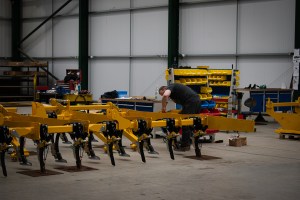
Labour continues to be the biggest challenge to the expansion of the business in 2023.
Repeating the trials over a five-year period is important to give a consistent return on investment, says Olmix’s Grant James. “Biostimulants perform best in adverse conditions, so if you have a year where conditions are good, you may not see them performing at their maximum potential. Trialling over five years, you’re less likely to have perfect conditions every year, and more likely to see their positive benefits.”
Looking to the future, Jeff says he hopes to continue the success of the past 40 years and keep delivering solutions to real, on-farm challenges. “It has been a good 40 years and with all the challenges agriculture is facing, there has never been a better time for systems like the Claydon. Now, it’s all about getting our ducks in a row to allow this natural expansion and evolution to happen.”
Spring success
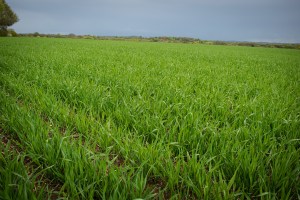
February-sown spring oats have been a success so far this season at the Claydon farm, with mechanical hoeing proving to be very valuable after the crops fell victim to a late germinating blackgrass flush.
While the OSR hasn’t fared overly well this season, something Jeff is pleased with is his spring oats. “We planted in February – it was a lovely month. Everyone said it was too early to drill, but we were looking at these lovely conditions and couldn’t resist. They look absolutely amazing now.”
The caveat to this is that because they were planted earlier in the spring, it allowed blackgrass to germinate during the wet period in March. “One must remember that as your soil health improves, everything wants to grow – including the weeds,” laughs Jeff.
However, in typical Jeff fashion, he has seen the challenge of extra weed pressure as an opportunity to refine mechanical hoeing techniques using the TerraBlade inter-row hoe.
“One of the problems we’re facing is the armoury of defence chemicals is fast diminishing – we’ve lost lots of grassweed controls and it’s these that are becoming more challenging for us,” explains Jeff. “Consequently, we can have very clean crops at Christmas but then grassweeds germinating in February, as we’ve had in our oats this year.
“When this happens, there are a few quite expensive chemicals to consider, but these haven’t been particularly effective for us. So, we’ve been looking at mechanical hoeing. Just recently, I hoed some spring oats, with a 6m hoe – travelling at 7mph – and covering more ground in a day than you would with a 6m drill. This keeps it extremely low cost.”
That said, the downside is that it’s not a 100% effective technique as only 50% of the soil surface is hoed, but it does take out the strongest grassweed competition which tends to grow between the bands, explains Jeff. “The good thing with a mechanical approach is the blades aren’t discriminative to resistant weeds – if they’re there, they’ll take them out.”
Even with the difficult wet spring we’ve had, Jeff says he has still been able to hoe the entire cereal area he wanted to – about 75%. “We did some trials with Agrii two years ago, and where they hoed we put another £200/ha margin on the crops in a previously badly affected blackgrass area. Who can afford to miss out on that sort of margin these days?”
CPM would like to thank Claydon for kindly sponsoring this article, and for providing privileged access to staff and material used to help put the article together.
This article was taken from the latest issue of CPM. For more articles like this, subscribe here.
Sign up for Crop Production Magazine’s FREE e-newsletter here.

